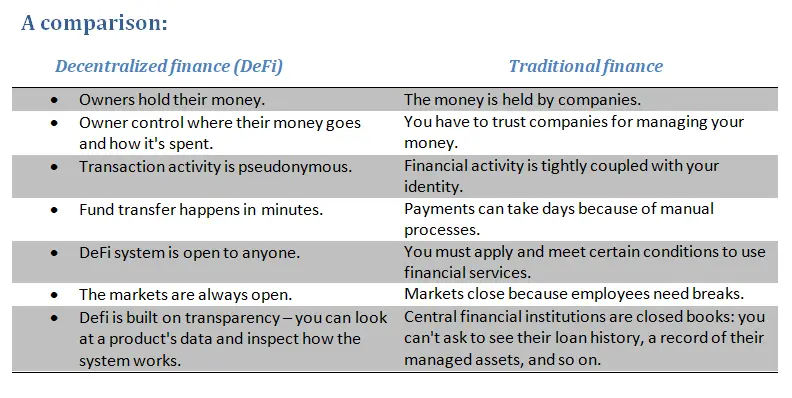DeFi, short for “decentralized finance,” is a system that makes financial products available on a public decentralized blockchain network that is not regulated by financial intermediaries like banks and national or international administration.
DeFi involves taking traditional elements of the financial system and replacing the middleman with a smart contract. Here smart contracts are automated enforceable agreements running on the blockchain that can execute automatically when certain conditions are met. In other words, you can think of Defi as a system where software written on blockchains makes it possible for buyers, sellers, lenders, and borrowers to interact peer to peer, rather than a financial institution facilitating a transaction.
Currently, Most of the DeFi protocols operate on the Ethereum blockchain, while some are now also hosted on other competing blockchains like the Solana network. Unlike a bank or other financial institution, you do not necessarily require to use a government-issued ID, proof of address, or any other identity proof to use DeFi.
Using DeFi lending, you can lend out cryptocurrency, just like a traditional bank does with fiat currency, and earn interest as a lender. Smart contracts allow developers to create far more sophisticated functionality(application) than simply sending and receiving cryptocurrency. These applications are called decentralized apps, or dapps.
So, dapp simply is an app that is built on decentralized technology, rather than being built and controlled by a single, centralized entity or firm. Many DeFi dapps are already live and available today that allows users to lend out money and earn interest on their crypto, create stablecoins (cryptocurrency whose value is pegged to the US dollar), exchange one asset for another, take out a loan, go long or short assets, as well as carry out automated, advanced investment strategies. DeFi dapps provide you with more control over your money through personal wallets and trading services that explicitly cater to you instead of institutions.

The components of DeFi are quite the same as those for traditional financial ecosystems, meaning it requires stable currencies and a variety of use cases. DeFi components take the form of stablecoins, which is a cryptocurrency whose value is pegged to the US dollar; and services such as crypto exchanges and lending services. Smart contracts, which are at the core of Defi, provide the framework for the functioning of dapps because they encode the terms and activities necessary for the functioning of these services. For instance, a smart contract code can have a specific code that establishes the exact terms and conditions of a loan between individuals. If certain terms or conditions are not met, collateral security could be liquidated. And all this gets conducted by the specific code written in smart contract rather than manually by a bank or other institution.
All sorts of traditional financial transactions including payments, trading securities, and insurance, to lending and borrowing, are already happening with DeFi. Some of the ways dapps and protocols are already being used:
Decentralized exchanges (DEXs):
Though, currently, a big number of crypto-investors use centralized exchanges like Coinbase or Gemini to buy, sell, or trade cryptocurrencies. Also getting momentum now are Decentralized exchanges, DEXs (like
Uniswap), that facilitate peer-to-peer financial transactions and let users retain control over their money. DEXes also reside on the blockchain which means they operate without a central authority, there is no exchange operator, no sign-ups, no identity verification, and no withdrawal fees.
DeFi wallets:
Developers are creating digital wallets that can operate independently of the largest cryptocurrency exchanges and give investors access to everything from cryptocurrency to blockchain-based games.
Stable coins:
Since cryptocurrencies are notoriously volatile, stable coins are those cryptocurrencies that attempt to stabilize their values by tying them to non-cryptocurrencies, like the U.S. dollar.
Borrow and Lend:
Compound which is an Ethereum based borrowing and lending dapp, allows you to lend your crypto out and earn interest on it. The platform automatically connects the lenders and borrowers, enforces the terms of the loans, and distributes the interest. Other popular borrow and lend dapps include Aave and dYdX.
Non-fungible tokens (NFTs):
NFTs are commodifying the previously uncommodifiable. NFTs create digital assets out of typically non-tradable assets, like popular photos, videos, audio, and other types of digital files as unique items, using blockchain technology to establish a verified and public proof of ownership.
Flash loans:
Borrowers also have the option to make money by entering into a smart contract, executing a transaction, and repays the loan instantly. In case the transaction can’t be executed, or it’ll be at a loss, the loan funds automatically go back to the loaner. If you invested smartly and made a profit, you can pocket it, minus any interest charges or fees. You can think of flash loans as decentralized arbitrage.
Conclusion
The decentralized finance revolution has hit its early adopter stage and is ready to cross the chasm into mainstream adoption in the coming years. Be it insurance, exchanges, staking solutions, or any other financial tools and services, you will be able to find a DeFi platform that has it covered. Defi can benefit a huge population that today suffers from financial prejudice, high fees, and inefficiencies in managing their funds.